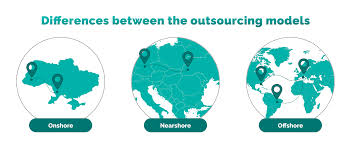Exploring the Benefits of Nearshore Software Development for Efficient Project Delivery
The Advantages of Nearshore Software Development
Nearshore software development has gained popularity in recent years as a strategic approach for companies looking to outsource their software development projects. This practice involves partnering with software development teams in neighboring or nearby countries, typically within the same time zone or a few hours’ difference.
Benefits of Nearshore Software Development:
Time Zone Compatibility: One of the key advantages of nearshore software development is the alignment of time zones. This allows for real-time collaboration between teams, making communication and project management more efficient.
Cultural Similarities: Working with nearshore teams often means sharing similar cultural values and business practices. This can lead to better understanding and smoother collaboration on projects.
Cost-Effectiveness: Nearshore outsourcing can offer cost savings compared to onshore development while maintaining high-quality standards. Companies can benefit from competitive pricing without compromising on the quality of work.
Access to Skilled Talent: Nearshore locations often have a pool of highly skilled IT professionals who can bring expertise and innovation to software development projects. This access to talent helps companies achieve their project goals effectively.
Reduced Travel Costs: Proximity to nearshore locations reduces travel costs associated with onsite visits and meetings. This makes it easier for teams to collaborate regularly without incurring significant expenses.
Conclusion
Nearshore software development offers numerous advantages for companies seeking efficient and cost-effective solutions for their software projects. By leveraging the benefits of nearshoring, businesses can enhance collaboration, access top talent, and achieve successful outcomes in their development initiatives.
7 Key Advantages of Nearshore Software Development for Your Business
- Time zone compatibility for real-time collaboration
- Cultural similarities leading to better understanding
- Cost-effectiveness with competitive pricing
- Access to skilled talent in nearshore locations
- Reduced travel costs for onsite visits and meetings
- Enhanced communication and project management efficiency
- Flexibility in scaling teams based on project requirements
6 Potential Drawbacks of Nearshore Software Development
- Language barriers may still exist, leading to communication challenges.
- Differences in work culture and practices can impact project alignment.
- Time zone differences, although minimized, can still pose scheduling difficulties.
- Intellectual property protection may be a concern due to varying legal frameworks.
- Quality control issues could arise if not managed effectively across borders.
- Dependency on external factors like political stability or economic conditions of the nearshore location.
Time zone compatibility for real-time collaboration
Time zone compatibility in nearshore software development facilitates real-time collaboration between teams, enabling seamless communication and efficient project management. By working with teams in neighboring or nearby countries that share similar time zones, companies can conduct meetings, address issues, and make decisions without delays. This synchronized workflow enhances productivity and ensures that project timelines are met effectively. The ability to collaborate in real-time fosters a sense of unity among team members despite geographical distances, leading to smoother coordination and successful project outcomes.
Cultural similarities leading to better understanding
One significant advantage of nearshore software development is the presence of cultural similarities between partnering teams, which fosters better understanding and collaboration. Shared cultural values and business practices create a conducive environment for effective communication, problem-solving, and project management. This alignment helps in building strong working relationships, enhancing team dynamics, and ultimately contributes to the successful delivery of high-quality software solutions.
Cost-effectiveness with competitive pricing
Nearshore software development offers a significant advantage in terms of cost-effectiveness with competitive pricing. By partnering with software development teams in neighboring or nearby countries, companies can benefit from lower costs compared to onshore development while still maintaining high-quality standards. This cost-saving aspect allows businesses to optimize their budgets effectively and achieve their software development goals without compromising on the quality of work delivered.
Access to skilled talent in nearshore locations
Access to skilled talent in nearshore locations is a significant advantage of nearshore software development. These locations often boast a rich pool of highly qualified IT professionals with expertise in various technologies and industries. By partnering with nearshore teams, companies can tap into this talent pool to access specialized skills, innovative solutions, and diverse perspectives that can elevate the quality of their software development projects. This access to skilled talent enables businesses to efficiently meet project requirements, drive innovation, and achieve successful outcomes in a competitive market landscape.
Reduced travel costs for onsite visits and meetings
One significant advantage of nearshore software development is the reduction in travel costs associated with onsite visits and meetings. By partnering with teams in neighboring or nearby countries, companies can minimize expenses related to travel, accommodation, and other logistical arrangements. This cost-saving benefit allows for more frequent and efficient collaboration between teams without the financial burden of extensive travel, ultimately contributing to a more streamlined and budget-friendly software development process.
Enhanced communication and project management efficiency
Enhanced communication and project management efficiency is a significant advantage of nearshore software development. By partnering with teams in neighboring or nearby countries within the same or similar time zones, companies can facilitate real-time collaboration, leading to clearer communication channels and streamlined project management processes. This alignment in time zones allows for quicker response times, seamless coordination of tasks, and improved overall efficiency in delivering high-quality software solutions.
Flexibility in scaling teams based on project requirements
One significant advantage of nearshore software development is the flexibility it offers in scaling teams based on project requirements. Companies can easily adjust the size of their development teams according to the specific needs of each project. Whether it’s ramping up resources for a large-scale initiative or scaling down for a smaller task, nearshore outsourcing allows for quick and efficient team adjustments, ensuring optimal resource allocation and project success. This adaptability in team scaling helps companies meet project deadlines, maintain productivity, and achieve cost-efficiency in their software development endeavors.
Language barriers may still exist, leading to communication challenges.
In nearshore software development, one significant drawback is the potential presence of language barriers, which can result in communication challenges between teams. While nearshore locations may share similar time zones and cultural practices, differences in language proficiency can hinder effective collaboration and understanding among team members. Misinterpretations and misunderstandings may arise, impacting project progress and overall productivity. It is essential for companies engaging in nearshore development to address language barriers proactively through clear communication strategies and language training initiatives to mitigate these challenges effectively.
Differences in work culture and practices can impact project alignment.
Differences in work culture and practices between the nearshore software development team and the client’s organization can pose a significant challenge in achieving project alignment. Varying approaches to communication, decision-making processes, and work methodologies may lead to misunderstandings, delays, or even conflicts during the project lifecycle. It is crucial for both parties to proactively address these differences through effective communication, cultural awareness training, and establishing clear expectations to ensure smooth collaboration and project success.
Time zone differences, although minimized, can still pose scheduling difficulties.
Despite efforts to minimize time zone variances, one notable drawback of nearshore software development is that even slight differences in time zones can still present scheduling challenges. While nearshore teams are typically located within a few hours of the client’s time zone, coordinating meetings and real-time collaboration can be impacted by these discrepancies. This can sometimes lead to delays in communication and decision-making processes, requiring careful planning and effective communication strategies to overcome scheduling difficulties and ensure project timelines are met efficiently.
Intellectual property protection may be a concern due to varying legal frameworks.
One significant drawback of nearshore software development is the potential concern regarding intellectual property protection. The varying legal frameworks across different countries can create ambiguity and challenges in safeguarding proprietary information and assets. Companies may face uncertainties about the enforcement of intellectual property rights, leading to risks of unauthorized use or disclosure of sensitive data. This issue underscores the importance of thorough due diligence and contractual agreements to mitigate the risks associated with intellectual property protection in nearshore development partnerships.
Quality control issues could arise if not managed effectively across borders.
Quality control issues could arise in nearshore software development if not managed effectively across borders. The distance and potential communication barriers between teams in different countries may lead to discrepancies in understanding project requirements, standards, and expectations. Without a robust quality control process in place that addresses these challenges, there is a risk of inconsistencies in the final deliverables, impacting the overall quality of the software product. Effective coordination, clear communication channels, and standardized quality assurance procedures are essential to mitigate this con and ensure that the software development meets the desired quality standards.
Dependency on external factors like political stability or economic conditions of the nearshore location.
One significant drawback of nearshore software development is the dependency on external factors such as the political stability and economic conditions of the nearshore location. Instability in these areas can disrupt operations, leading to delays in project timelines, communication challenges, and potential risks to data security. Companies engaging in nearshore outsourcing must carefully assess and monitor these external factors to mitigate any potential negative impacts on their software development projects.




